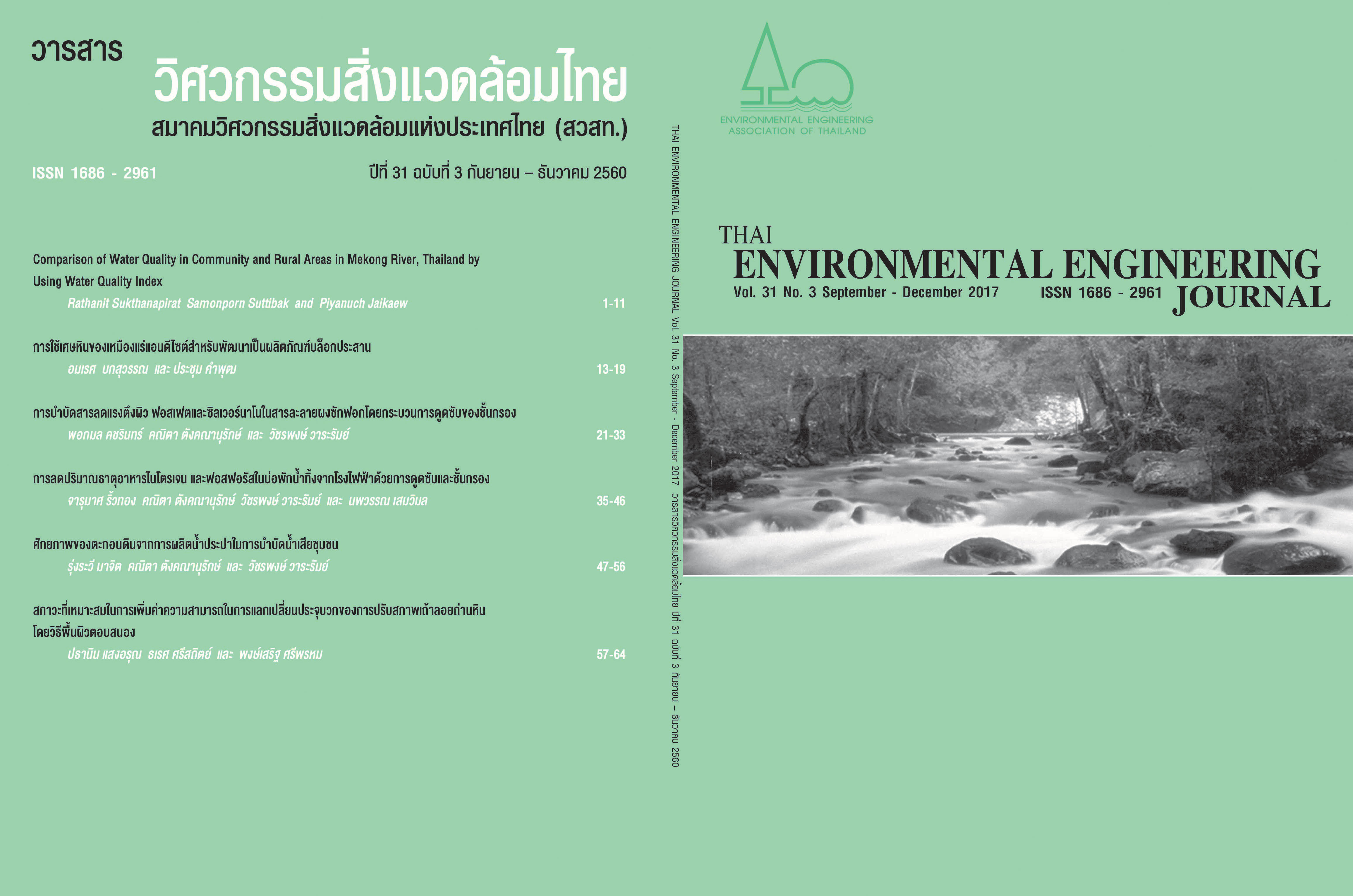Potential of Waterworks Sludge in Community Wastewater Treatment
Main Article Content
Abstract
The potential for reuse of waterworks sludge (WWS) in community wastewater treatment was investigated. Silica and alumina recovery were the main compositions of WWS. Moreover, from experimental results of chemical properties analysis revealed that the WWS consists of the organic matter 2.42%, available phosphorus 0.89 mgkg-1, NH4+-N 6.43 mgkg-1, NO3--N 101.70 mgkg-1, potassium 79.91 mgkg-1 and magnesium 48.29 mgkg-1. SEM micrograph observed under scanning electron microscope (SEM), the amorphorus structure and uneven plate was found on sludge surface. From Jar test experiment in lab scale, one gram of WWS per 0.5 L of Kasetsart University, Bangkhen community wastewater (KUCW) can be removed turbidity at 98.02±0.12% at pH 7.0 and settling time 3 days. The pollutants treatment efficiency was carried out on COD, dissolved inorganic nitrogen, dissolved inorganic phosphorus (DIP) solution by batch experiments. The results was found that 1 gram of WWS removed pollutants in 50 mL of each pollutant solutions 50 mgL-1 COD and 10 mgL-1 NO3--Nat 100%, 100 mgL-1 NH3-N at 46.78±0.67%, 10 mgL-1 DIP at 41.40±0.34% and decreased Oil and Grease from 350 to 100 mgL-1 in wastewater. Before the study of pilot scale experiment, the jar test experiment of 0.5 L of KUCW was carried out. It was found that 1 gram of WWS at pH 7 and settling time 1 day was the suitable condition. After treatment all of studied parameters were agree with surface water quality standard. Furthermore, in pilot scale experiment, 20 L of KUCW was treated by 40 g of WWS, at pH 7 and settling time 1 day. The results showed that the water quality of the treated water was as good as in lab scale and better than AS system. Moreover, used WWS had a more nutrients and also used in cultivation.
Article Details
References
[2] Irb kheoruenromne, Anchalee Suddhiprakarn, Suthep Thongpae, Piboon Kanghae, Saowanuch Tawornpruek, Somchai Anusontpornperm, Wipawan Thaymuang, Prisana Suasamserm and Naruekamon Janjirawuttikul. 2001. Study of Waterworks Sludge for develop in agricultural and industrial. kasetsart university, Bangkok. 72 pages.
[3] Xiao-Hong Guan, Guang-Hao Chen and Chii Shang. 2005. Re-use of water treatment works sludge to enhance particulate pollutant removal from sewage. Water Research. 39: 3433-3440.
[4] Hu, Y.S., Y.Q. Zhao and B. Sorohan. 2011. Removal of glyphosate from aqueous environment by adsorption using water industrial residual. Desalination. 271:
150-156.
[5] Walkley A, Black IA. Chromic acid titration method for determination of soil organic matter. Soil Sci. 1947; 63: 251-257.
[6] Bray R, Kurtz LT. Determination of total organic and available forms of phosphorus in soils. Soil Sci. 1945; 59: 39-45.
[7] APHA, AWWA. and WEF. 2012. Standard Methods for the Examination of Water and Wastewater. 22nded. American Public Health Association, Washington, DC.
[8] Land development department. 2010. Soil analysis process. Receive from http://www.ldd.go.th/PMQA/2553/Manual/OSD-03.pdf (November 2016)
[9] Department of primary industries and mines. 2004. Waterworks Sludge for apply. Receive from http://www.dpim.go.th/en/(November 2016)
[10] Babatunde, A.O., Zhao, Y.Q., Yang, Y., Kearney, P. 2008. Reuse of dewatered aluminium-coagulated water treatment residual to immobilize phosphorus: batch and column trials using a condensed phosphate. Chem. Eng. J. 136: 108-115.
[11] Papavadee Choksuwannakit. 2007. Treatment of molasses distillery slop using water treatment sludge asphalt ash and hydrogen peroxide. Thesis, Chulalongkorn University.
[12] Jitthep Prasityousil. 2000. Reusing sludge from water treatment plant for reducing phosphorus from municipal wastewater. Research Report, Chiang Mai University.
[13] Abhilash T. Nair and M. Mansoor Ahammed. 2015. Water treatment sludge for phosphate removal from the effluent of UASB reactor treating municipal waste water. Process Safety and Environmental Protection 94: 105-112.
[14] Chuchitt Sagwansupyakorn. 2009. Utilization of data from soil analysis results. Receive from http://e-library.ldd.go.th/web_km/Data/re_7.pdf (November 2016)


